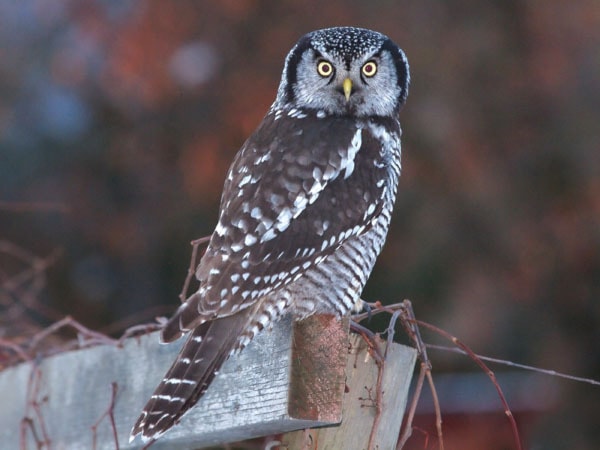Bird fans got more than they bargained for Sunday, Dec. 18, when they sighted the rare northern hawk owl.
Ted Hillary, Margaret Filiatrault and Clive Bryson were thrilled and excited to see the owl, a species that has not been seen in the area for a decade.
“I managed to get several close-up shots after it flew to a spot very close to where I was standing,” says Bryson.
Hillary, a member of the Shuswap Naturalists and organizer of this year’s annual bird-count, says 24 people joined the naturalists as they took part in the 112th Annual Audubon Christmas bird count.
“We saw, for the first time, Eurasian collared doves. They’re like a mourning dove, a new bird to North America. They started probably in the Bahamas, escaped over to Florida and then colonized North America in about 20 years,” says Hillary.
“We’ve had them during summer and winter, but never in our Christmas bird count. This year we got 21.”
All told, birdwatchers counted 72 species of bird this year, with a total of 7,881 birds: 311 trumpeter swans, 1,320 Canada geese, 1,017 mallard ducks, 10 or so different kinds of other ducks, 28 red-tail hawks, 35 bald eagles and 25 California quail.
“That’s dry-belt bird and relatively new here,” Hillary says. “We get more of them as it gets drier.”
Also counted Sunday were 22 pheasants, 46 mourning doves, 653 pigeons, 85 northern flickers (woodpeckers), nine pileated woodpeckers, 335 ravens, 582 crows, 305 black-cap chickadees, 17 mountain chickadees and one chestnut-backed chickadee.
“That’s very rare here, they’re more of a coastal chickadee,” he says.
“The starlings, which people know well, there were a lot of them at 723.”
Hillary says 198 redwing blackbirds were also counted, because the weather’s hasn’t been too bad and there’s food available to eat.
The Shuswap Naturalists began their annual bird-count early in the 1970s but didn’t join in the Audubon Count until 1989.
Thrilled to have seen the northern hawk owl, Hillary says the birds are residents of the boreal forest.
“Occasionally some will move south in the winter, like what the snowy owls are doing now in Delta,” he says.
“We very seldom get hawk owls here. This one could stay into February if the food supply is adequate.”
He says the last reported sighting here was 10 years ago, in the North Broadview area.
“They are a daytime hunter, their diet is primarily rodents,” he says. “They have very keen eyesight – up to a kilometre, and can detect and capture a rodent 30 centimetres under the snow. “
Anyone interested in more information or in becoming a member of the Shuswap Naturalists Club may call Barbara or Ted Hillary at 250-832-4755.
